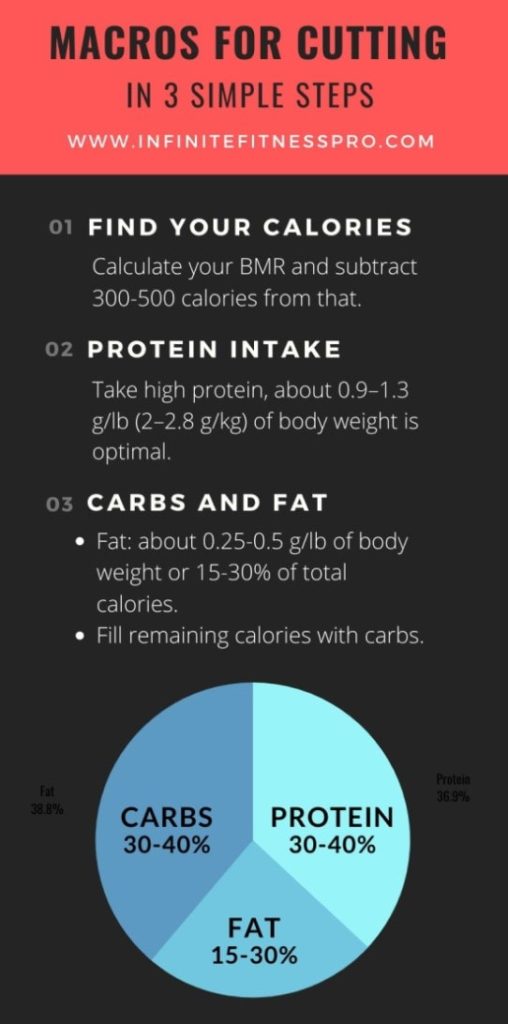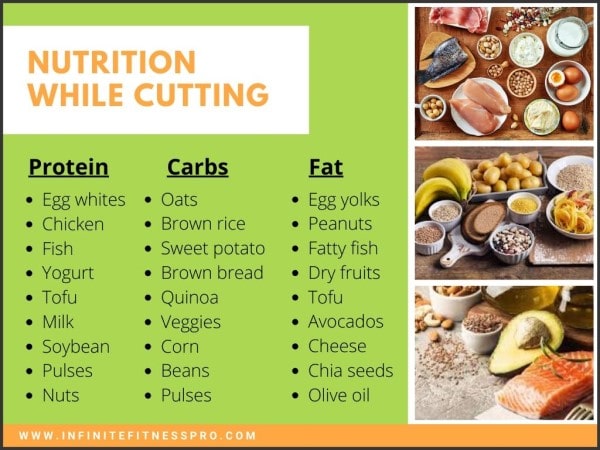Are you aiming for losing fat to get that lean and ripped physique but confused about setting up your macros for cutting diet? Don’t worry, here’s the complete guide explaining how to calculate macros for cutting diet.
When it comes to fat loss or cutting, your diet or nutrition is the most important factor. So keep reading and follow the steps to find your macros for cutting.
What is Cutting?
There are mainly two phases in bodybuilding, bulking and cutting.
In bulk, the goal is to gain muscle mass while minimizing fat gain. Here’s the article explaining how to find your macros for lean bulk in 3 simple steps.
In the cutting phase, the goal is to lose fat while preserving the maximum muscle mass possible. After gaining a decent amount of muscle mass, you should go into the cutting phase to get a lean and ripped physique.
Studies have shown this multiple times that during the cutting phase, you need to be in a calorie deficit – that means eating fewer calories than you need. But just eating less is not the solution.
You have to set a proper macro ratio, otherwise, you may lose your hard-earned muscles. So here’s the blueprint for calculating macros for cutting diet.
Macros for Cutting Diet in 3 simple steps
The three main aspects you must focus on to optimize your cutting diet are:
- Total number of calories
- Protein intake
- Carbohydrates and fat
Optimize these three factors, and you are good to go on a cutting phase.

Step 1 – Determine your calories
The number of calories you consume is the most important factor in fat loss or cutting diet. To put your calorie intake in check, you have to determine how many calories you need to cut.
First, calculate your BMR (Basal Metabolic Rate)
BMR is the estimation of calories you need to consume to maintain your weight. To calculate your BMR, just type the “BMR calculator” on google or click on this link to check.
On the basis of your age, gender, height, and activity level, BMR gives a rough estimate of calories you need to consume to maintain your current body weight.
Set a calorie deficit
Now, this is something critical. To fasten the cutting process, people usually go on an extreme caloric deficit. This often leads to muscle loss and they end up looking skinny fat.
Remember, our goal is to maximize fat loss, not weight loss. So the best way to get a ripped body with good muscle definition is to do a moderate calorie deficit.
Else, you can directly get your daily calories by using this calorie deficit calculator.
So, just reduce 300-500 calories from the maintenance number you got through the BMR calculator.
You can do it manually too
Multiply your body weight (in pounds) by 13 or 14 and you’ll get the number of calories you need to consume daily for cutting.
So, for a 160 lbs individual, the daily calorie intake would be around 2080 (160 x 13) or 2240 (160 x 14).
However, this may not be the exact number for everyone. Start with this and then you can adjust your calories based on how your fat loss progresses.
Step 2 – Protein intake
Protein is the most important nutrient you need to monitor. Several studies have shown that your body needs enough protein to maintain muscles, especially when you are in a calorie deficit.
While cutting, your body needs a higher amount of protein than you need in bulk.
So how much protein do you need while cutting?
About 0.9 – 1.3 g/lb (2 – 2.8 g/kg) of body weight is the optimal range of protein that you need while cutting or fat loss.
For most people, 1 g/lb or 2.2 g/kg of body weight is good enough but if you are an advanced-level athlete, then it is better to stick to the higher side.
Protein is a very satiating nutrient. So in addition to minimizing muscle loss, protein keeps you full and helps you in eating less throughout the day.

You should have read: 13 High Protein Foods to gain lean muscle mass.
Step 3 – Carbs and Fat
No doubt, protein is the most important macronutrient while setting up macros for cutting diet, but the body needs carbs and fats too.
You need enough carbs to fuel your workouts in the gym and boost your performance. Healthy fats are also important for joint health, brain health, hormones, and some other essential body functions.
So how much carbs and fat do you need while cutting?
First, set up your fat intake
According to the Journal of the International Society of Sports Nutrition,
The general recommendation for fat intake for cutting diet is about 0.25-0.5 g/lb (0.55-1.1 g/kg) of body weight or 15-30% of total calories.
Make sure to get most of your fat from healthy sources like egg yolks, walnuts, flax seeds, chia seeds, peanuts, avocados, fatty fish, coconut oil, etc. Try to avoid saturated fat (like animal fat) as much as you can.
For carbs
After subtracting the number of calories from protein and fat, fill up the rest of your calories from carbs.
Remember, all carbs are not the same. Complex carbohydrates are low in GI (Glycemic Index). Most of the time eat complex carbohydrates only – brown rice, brown bread, rolled oats, sweet potato, green veggies, quinoa, etc.
A sample macro distribution for cutting diet
Let’s understand with a simple example that how to calculate macros for cutting diet.
1. Calories
Let’s say John weighs 160 lbs and after calculating his BMR, his maintenance calories come out to be 2300.
His muscle mass is pretty good and has a low body fat comparatively, hence he decided to go on a deficit of 300 calories.
So John would take 2000 calories daily.
2. Protein
As an intermediate, John is taking 1.1-gram protein per lb of body weight. So his daily protein intake would be 160 x 1.1 = 176 g of protein or 175 g approximately.
3. Carbs and fat
For fat, he decided to take 25% of total calories so: 2000 calories x 25% = 500 calories from fat.
Since 1 gram of fat contains 9 calories so, 500 calories / 9 = 55 g of fat.
Now for carbs, total daily calories – calories from protein and fat = calories from carbs i.e,
2000 calories – (175 g of protein x 4) – (500 calories from fat) = 800 carb calories / 4 = 200 g of carbs.

How to train for cutting
In achieving an athletic physique, workout and nutrition go hand in hand. So in addition to setting up your macros for cutting diet, you have to optimize your workout too.
Here are some tips you should consider regarding cutting or fat-loss workouts:
Lift heavy: During cutting, there always be the risk of losing some muscle mass too as you’re in a calorie deficit. Hence, lifting heavy weights gives your muscles a reason to retain and helps in reducing muscle loss.
Read more: High reps lightweight for fat loss, or just a myth?
Avoid doing cardio first: Starting up a workout with cardio is a big mistake that most people do. Do cardio after weights or do it in a different session altogether.
Don’t do too much cardio: Stop doing hours and hours of cardio. By doing too much cardio, your body can go into a catabolic state, leading to muscle loss.
SUMMARY: Macros for Cutting Diet
So this was a science-based article explaining how to calculate macros for cutting diet. I tried to explain it in the simplest way possible. Here’s the takeaway:
While cutting or shredding that extra layer of fat over the muscles to get a lean and ripped physique, start with a slight deficit of about 300 calories.
A higher calorie deficit may lead to muscle loss hence I recommend going for a moderate deficit.
Eat clean and healthy, and avoid junk like saturated fat or refined sugar as much as you can.
Fill up those calories with 0.9-1.3 g/lb body weight of protein, 0.25-0.5 g/lb body weight of fat, and remaining with carbs.
Thanks for reading this far. I hope you like the article and learned something from this.
If you have any queries related to fitness, just leave a comment below.



